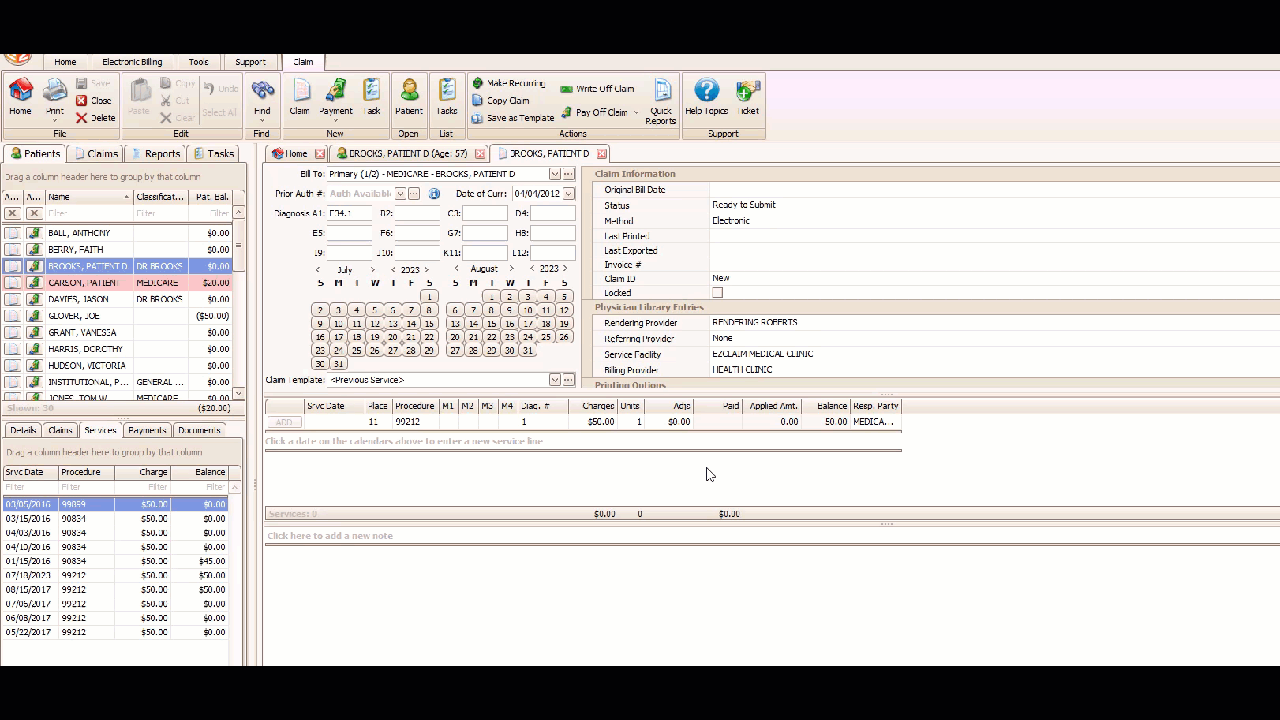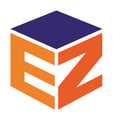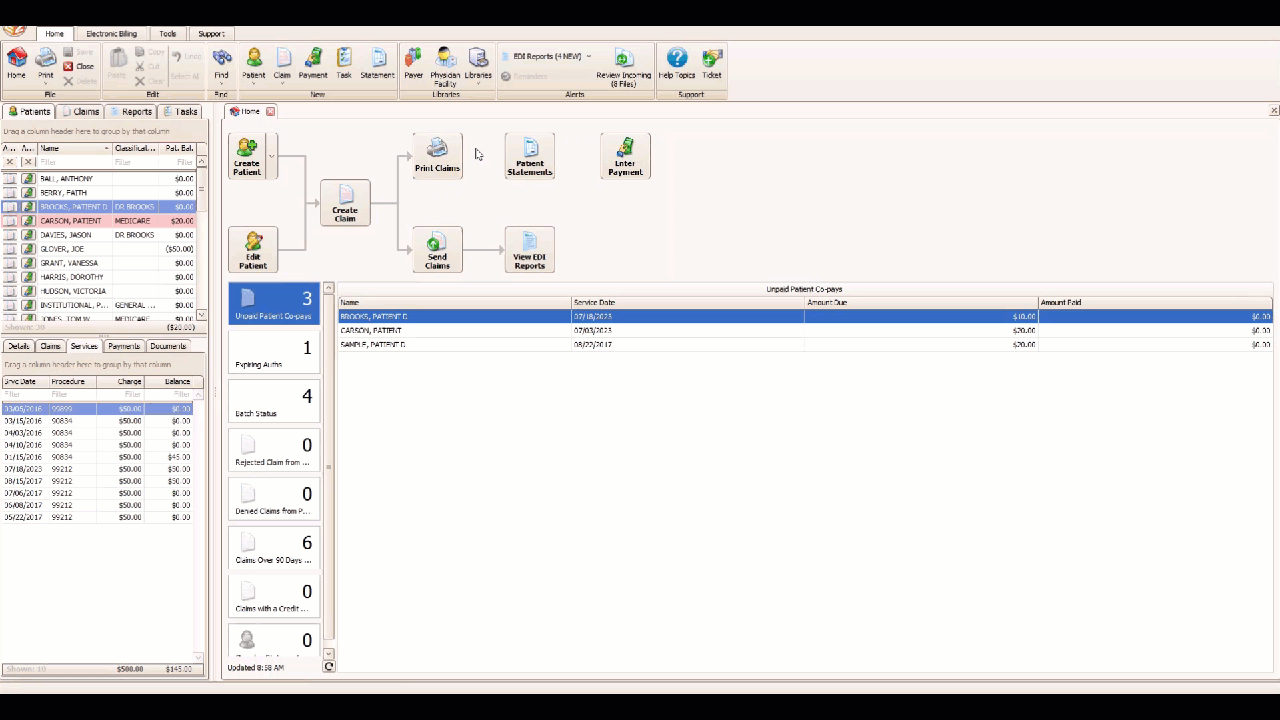Everything you need to know about your Authorization Library, from basic to advanced
The Authorization Library enables users to effectively monitor the number of units permitted and the remaining units for a specific procedure code.
To easily navigate this article, use the links provided below. At the end of each section, click "Back to Top" to return to this menu.
How it Works
- Authorization limit messages are displayed solely when entering new claims. The program will not display authorization limit messages when modifying data on existing claims.
- The calculation of Units and Dollars Remaining is based solely on service lines that are within the authorization date range.
Note: Authorizations are typically assigned at the claim level, meaning that the same authorization number is associated with all service lines on the same claim.
However, starting from release 650, it is now possible to assign different authorizations to individual service lines if required by your payer.
- At the Service Line level, an ‘Authorization Override’ field can be added to the grid via the Column Chooser.

Note: At the Payer Library level, an Export Authorization in Loop 2400’checkbox is available. Do not check this box unless required by your payer.
Entering Authorizations
- Click in the field Click here to add a new authorized units library entry to open the fields for data entry
- Select Patient using the drop-down arrow *Required
- Select Payer using the drop-down arrow *Optional
- ‘None’ is a valid option if you want the authorization to be available to any payer listed on the claim
- Continue entering Authorization information as needed
Note: To customize the column headings, right-click on any column heading and select Column Chooser. Then, drag and drop the selection to the desired heading. For more information, please refer to the Column Chooser article.
Tip: Right-click an entry to open the patient record.
Advanced Techniques
- Rendering Phy – To enhance the functionality of the grid, you have the option to add a Rendering Phy column using the Column Chooser. When this column is used, the authorization will only be displayed if the correct rendering provider is selected on the claim.
Note: Authorizations without a rendering provider will be shown regardless of the claim’s rendering provider.
- Wildcard -If there are multiple procedure codes within the same family of codes, you have the option to use the wildcard character % at the end of the procedure code fragment. By entering 98%, the program will count any procedure code that starts with 98.
- Multiple Entries – If multiple procedure codes require the same authorization number, you can enter the authorization number multiple times, once for each procedure code.
- Modifiers –If your authorization covers both the procedure and modifier, you have the option to enter modifiers into the Mod 1 through Mod 4 columns. EZClaim will then only count down authorizations if the procedure code and modifiers match.
- If you leave the authorization modifier fields blank, EZClaim will only consider the procedure code when calculating the units. Regardless of whether modifiers are entered on the service line, the units will still be counted down.
- Product Code – If you are using product codes during data entry, you may need to include the product code in the authorization library entry. The product code column is not normally visible, but you can add it using the Column Chooser. By entering a product code, only the service lines that have that specific procedure/product code combination will be counted for units and dollars used.
- Hide – To hide the data for archive purposes but remove it from selection on claims, click the 'Hide' button. To reverse this process and make the data available again, click the 'Show' button. Please note that all authorizations will still be visible in the Authorization Library.
- Multiple Claim Level Authorizations – To avoid any issues, it is important not to include multiple authorization numbers separated by commas (without spaces). This will prevent multiple G1 segments from being created in Loop 2300 of your ANSI file.
Note: It is advisable not to send multiple claim-level authorizations unless specifically required by the payer.
Note: See the 'How It Works' section above if your payer requires multiple authorizations at the service line level instead of the claim level.
Tracking Authorized Visits (Optional)
Please note that EZClaim Scheduler tracks visits only and not units. Therefore, EZClaim recommends tracking authorizations in either Scheduler or Billing, but not both.
The Authorization Library is specifically designed to track the number of units authorized for a procedure code. However, it also has the additional capability of tracking visits by counting the dates of services instead.
To track visits instead of units, follow these instructions:
- Enter the name and number of the authorization
- In the "Procedure Code" column, enter the word "VISITS"
- In the "Units Allowed" column, enter the number of visits allowed
- Please note that the "Dollars Allowed" column is not considered when tracking visits.
EZClaim will deduct the remaining visits by counting the number of unique dates of service on all claims that utilize the authorization number.
Blank Authorizations (Release 667 and higher)
EZClaim now offers the option to track authorizations for specialties like PT and OT that are based on the number of visits within a specific timeframe, without requiring an authorization number. This feature is designed to accommodate the unique needs of these specialties and streamline the authorization tracking process.
To take advantage of this feature, simply create an authorization as usual, but instead of entering a specific authorization number, input the term "BLANK" (case-insensitive) in the Auth Number field.
This will enable EZClaim to internally track and deduct authorization units without exporting the authorization number on electronic or paper claims.
This feature can be used with both Professional and Institutional claims.
Tip: If you still want distinct authorization numbers in the library, enter any value in Auth Number but prefix it with BLANK to prevent it from exporting or printing.
Importing Authorizations from an ANSI 278
To import authorization data from an ANSI 278 file, simply double-click on the ANSI 278 file in the 'View EDI Reports' window.
EZClaim will automatically parse the ANSI 278 file and display a preview of its contents in a separate window.

If EZClaim cannot find the patient, it will highlight the record. You can double-click to link it to an existing patient.
Select the rows you want to import by checking the box next to them, and then click the 'Import Authorizations' button.

